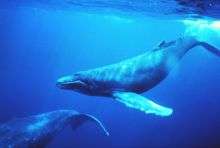Humpback whales able to learn from others, study finds

Humpback whales are able to pass on hunting techniques to each other, just as humans do, new research has found. A team of researchers, led by the University of St Andrews, has discovered that a new feeding technique has spread to 40 per cent of a humpback whale population. The findings are published today by the journal Science.
The community of humpback whales off New England, USA, was forced to find new prey after herring stocks – their preferred food - crashed in the early 1980s.
The solution the whales devised – hitting the water with their tails while hunting a different prey – has now spread through the population by cultural transmission. By 2007, nearly 40 per cent of the population had been seen doing it.
Dr Luke Rendell, lecturer in the School of Biology at the University of St Andrews, said: "Our study really shows how vital cultural transmission is in humpback populations – not only do they learn their famous songs from each other, they also learn feeding techniques that allow them to buffer the effects of changing ecology."
The team - also including Jenny Allen from the University of St Andrews, Mason Weinrich of the Whale Center of New England and Will Hoppitt from Anglia Ruskin University - used a new technique called network-based diffusion analysis to demonstrate that the pattern of spread followed the network of social relationships within the population, showing that the new behaviour had spread through cultural transmission, the same process that underlies the diversity of human culture.
The data were collected by naturalist observers aboard the many whale-watching vessels that patrol the waters of the Gulf of Maine each summer.
Dr Hoppitt said: "We can learn more about the forces that drive the evolution of culture by looking outside our own ancestral lineage and studying the occurrence of similar attributes in groups that have evolved in a radically different environment to ours, like the cetaceans."
Humpbacks around the world herd shoals of prey by blowing bubbles underwater to produce 'bubble nets'.
The feeding innovation, called 'lobtail feeding', involves hitting the water with the tail before diving to produce the bubble nets.
Lobtail feeding was first observed in 1980, after the stocks of herring, previously the main food for the whales, became depleted.
At the same time sand lance stocks soared, and it would seem the innovation is specific to that particular prey, because its use is concentrated around the Stellwagen Bank, spawning grounds where the sand lance can reach high abundance.
Using a unique database spanning thirty years of observations gathered by Dr Weinrich, the researchers were able track the spread of the behaviour through the whales' social network.
Jenny Allen said: "The study was only made possible because of Mason's dedication in collecting the whale observations over decades, and it shows the central importance of long-term studies in understanding the processes affecting whale populations."
The scientists believe their results strengthen the case that cetaceans - the whales and dolphins - have evolved sophisticated cultural capacities.
The skills, knowledge, materials and traditions that humans learn from each other help explain how we have come to dominate the globe as a species, but how we evolved the capabilities to transmit such knowledge between ourselves remains a mystery that preoccupies biologists, psychologists and anthropologists.
More information: "Network-Based Diffusion Analysis Reveals Cultural Transmission of Lobtail Feeding in Humpback Whales," by J. Allen et al. Science, 2013.
Journal information: Science
Provided by University of St Andrews


















